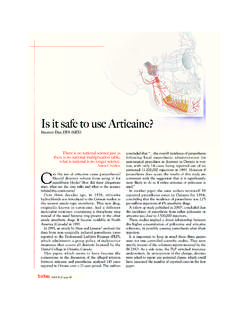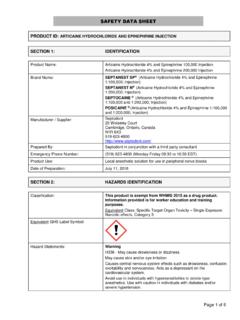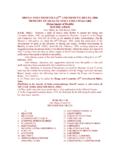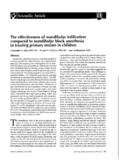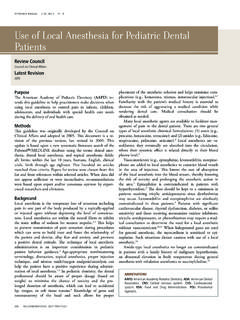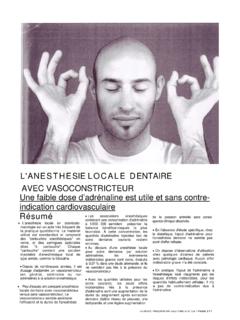Transcription of BLINDNESS! ATERRIBLE AFTERMATH OF …
1 REVIEW ARTICLE. ISSN No-2321-1482. DJAS 2(II), 64-73, 2014. All rights are reserved of A d v a n c e S t u d i e s blindness ! A TERRIBLE AFTERMATH OF DENTAL TREATMENT. Vandana Chhabra1, Ajay Chhabra2. 1. Reader, Dept. of Oral and Maxillofacial Surgery, SKSS Dental College & Hospital, Ludhiana 2. Professor and Head, Dept. of Conservative Dentistry and Endodontics, Bhojia Dental College and Hospital, Baddi, Himachal Pradesh. ABSTRACT. Local anesthetics are the most commonly used drugs in dentistry. Despite preoperative patient evaluation, proper tissue preparation and meticulous administration techniques many local and systemic complications with the local anesthesia or tooth extraction have been reported from time to time. Extension of dental infections from maxillary teeth and other nearby structures to orbital spaces and tissues surrounding the eye present a rare but serious problem with the potential for causing significant impairment.
2 The practioner should be aware of the severe consequences that may result from tooth extraction or local anesthesia. Key words: Local anesthesia, Ocular complications, Tooth extraction INTRODUCTION times involve structures further from oral cavity, including middle ear4 and Ocular complications after oral and Patients have experienced visual or motor maxillofacial procedures have been problems, either from post. Sup. Alveolar reported in many publications. These injection or an inf. Alveolar injection. complications can be because of Visual problems include blurring of administration of local anaesthesia or vision, 6 , 7 amaurosis or blindness extension of dental infections from (temporary or permanent).8-11 Motor maxillary teeth or other neighbouring problems include mydriasis, palpebral structures to orbital spaces and tissues ptosis and diplopia.
3 Horner-like surrounding eye . Spread of infection may manifestations involving ptosis, be direct extension by way of fascial enophthalmos and miosis of the eye have spaces, hematogenously, or along also been reported. lymphatics. DISCUSSION. Traumatic eye injury after dental There is little doubt that local anesthesias procedures was rarely reported in the used in dentistry are safe agents. medical literature, like transient blindness Complications associated with LA can be after dental extraction1, intraocular divided into systemic and regional, as also haemorrhage during dental implant those determined by the local anesthetic 2. surgery or even retinal tear after teeth agents used and the technique of 3. cleaning. administration. Some of the systemic reactions include vasovagal syncope, Local anesthetic drugs are routinely anaphylactic shock, toxicity, tissue administered for oral & maxillofacial necrosis, and facial nerve palsy; and the surgical procedures.
4 Despite careful ophthalmic complications include Corresponding Author: patient evaluation,proper tis s ue temporary blindness , diplopia, temporary Vandana Chhabra prepration, & a meticulous administration Mobile: +91- 9872776653 paralysis of cranial nerves III, IV, and VI, E-mail: t e c h n i q u e , l o c a l & s y s t e m i c oculomotor muscle paralysis, mydriasis, complications associated with local palpebral ptosis, and even permanent Received: 23 March 2014 anesthesia occasionally develop. The rd blindness . th Accepted: 19 Aug 2014 complications of local anesthesia may at Online: 20th Sept 2014. 64. Dental Journal of Advance Studies Vol. 2 Issue II- 2014. Wei Cheong Ngeow et al12 reported 2 cases of meningeal arteries and, finally, from the lacrimal to the transient loss of power of accommodation in 1 eye ophthalmic artery by way of anastomotic connections.
5 Following inferior alveolar nerve block. Both the The maxillary artery has been shown to have a highly patients were given inferior alveolar nerve blocks. The variable relation to the branches of the mandibular first patient recovered after 15 minutes and the affect in neurovascular bundle20 and enormous individual varia- the second patient lasted for 10 minutes. tion in its topography, diameter, size of the downward loop and its position relative to the mandibular Fortunately, most complications in the eye have been The middle meningeal artery can arise as the transient. For example, Rood8 in 1972 reported a case second major branch of the maxillary in which mL of lidocaine with epinephrine Moreover, in 4% of patients, the ophthalmic artery (1:80,000) was injected into an inferior alveolar nerve. arises not from the internal carotid but from the middle Immediate loss of vision developed in the ipsilateral meningeal artery following direct flow from the eye, along with upper-eyelid ptosis and medial 22.
6 External carotid artery. These variations have been strabismus, which resulted in double vision. The postulated to contribute to ocular complications patient also developed ischemia of the palatal mucosa. following intraoral local anesthetic injections. Other However, within 5 45 minutes, all symptoms had authors have proposed the existence of vascular disappeared. Unfortunately, cases of permanent malformations or anomalies that may produce the complications have also been retrograde anesthetic diffusion phenomenon. 23, 24. Among complications involving the orbit, the most Data obtained by contrast radiography and hemo- notable are temporary paralysis of the cranial nerves dynamic and electroencephalographic studies in rhesus that govern eye movement: the oculomotor (CN III), monkeys indicated that carotid blood flow is trochlear (CN IV) and abducens (CN VI) , 13-17 25.
7 Reversible. Results showed that even small amounts of local anesthetic agents, when injected inadvertently According to Pickering18 the loss of power of into a branch of the external carotid artery, may enter accommodation is a consequence of the paralysis of the the cerebral circulation, most likely through retrograde ciliary muscle either due to injury or anesthesia of CN flow into the common and then internal carotid arteries. III. When complete, paralysis of CN III results in Thus, another possible mechanism to explain the loss ptosis, external strabismus, dilatation of the pupil and of power of accommodation is the retrograde flow of loss of power of accommodation as the sphincter local anesthetic agent to the cavernous sinus area. As pupillae, the ciliary muscle and the internal rectus are any cerebral disease causing pressure on the cavernous paralyzed.
8 Occasionally paralysis may affect only a sinus will result in paralysis of the CN III18 due to their part of the nerve. Thus, there may be internal close proximity the same way , rather than cerebral strabismus from spasm of the internal rectus;. disease, the cause of paralysis of the nerve concerned accommodation for near objects only from spasm of could be deposition of local anesthetic via retrograde the ciliary muscle; or miosis (contraction of the pupil). flow. from irritation of the sphincter of the Transient diplopia in dental outpatient clinic has been Blaxter and Britten19 reported several cases involving 25. reported by SM Balaji where a healthy 32-year-old transient amaurosis and diplopia, and postulated that an female patient felt double vision after few minutes of intra-arterial injection of the inferior alveolar artery posterior superior alveolar block anesthesia.
9 The had occurred, with the anesthetic agent travelling to the condition was subsequently diagnosed as transient internal maxillary artery, the middle meningeal artery diplopia due to temporary paralysis of lateral rectus and, finally, the lacrimal and ophthalmic arteries. muscle due to involvement of the VI cranial nerve. The patient recovered in 30 minutes and the treatment was Goldenberg14, 15 reported a similar case following a man- performed successfully. dibular injection, and traced the anesthetic to the lacrimal artery. Rood8 also described a possible arterial Maxillary local anesthetic injections, particularly those route for diffusion of a vasoconstrictive agent from the deposited near the pterygoid canal are known to cause alveolar artery to the internal maxillary and middle diplopia of the ipsilateral eye and are estimated to occur 65.
10 Dental Journal of Advance Studies Vol. 2 Issue II- 2014. in about of cases. This often results from the Several explanations have been put forward to explain local anesthesia diffusing superiorly and medially to the phenomenon. 29. anesthetize the orbital nerves. There are no known 26 30. reports in the literature of permanent diplopia. The Alexander Kiderman and Jawad A. A. Tair in their hypothesis for ophthalmological manifestation of an article An eye for a tooth proposed a possible link inferior alveolar nerve block has been proposed as local between dental extraction and intra-ocular anesthetic solution reaches the orbit through vascular, complications. They reported a case of 49-year-old 27. neurological and lymphatic network. They proceed to healthy female who underwent surgical extraction of describe that oculomotor disturbances after injection of root canal treated second right upper molar tooth.

